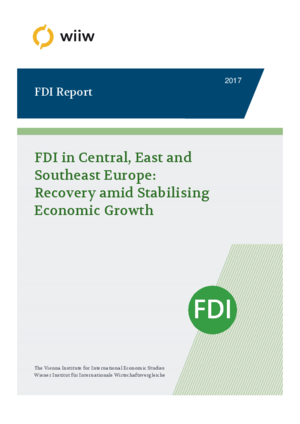Recovery amid Stabilising Economic Growth
Gabor Hunya and Monika Schwarzhappel
wiiw FDI Report No. 2017-06, June 2017
153 pages including 108 Tables and 9 Figures
The economic environment for foreign direct investment (FDI) has improved. A cautious upturn in economic activities across the Central, East and Southeast European (CESEE) region is based on expanding private consumption. Investments have started to recover, increasing opportunities for foreign business. Also, the most important foreign markets for CESEE products in Europe and overseas have stabilised, albeit amid increasing uncertainty. The CESEE region has maintained its cost competitiveness, despite surging wages and occasional labour shortages, by benefiting from considerable productivity improvements.
FDI inflows to the CESEE countries increased by 45% in 2016, compared with the revised 2015 data. The invested amount of EUR 90 billion is the highest since 2008, marginally surpassing the inflows reported in 2011 and 2012. The 2016 recovery was 23% in the EU’s Central and East European region and almost 150% in the Commonwealth of Independent States (CIS) and Ukraine; meanwhile the Western Balkans and Turkey booked a decline of 25%. The 2016 changes were in just the opposite direction to 2015, when FDI in the Western Balkans and Turkey boomed, while it declined in the other two regions. A special section of this report analyses the position of Austria as investor and investment destination for CESEE countries.
A separate section presents new features of greenfield investments in 2016: an increasing number of projects and higher capital investments that increasingly focused on the manufacturing sector. Forecasts for FDI in 2017 point upwards again, because the international environment is positive, although plagued by uncertainties, and also economic growth in most of CESEE is bound to be more robust than in the previous year.
The second part of this report contains two sets of tables: Tables I cover FDI flow and stock data, FDI flows by components and related income; Tables II provide detailed FDI data by economic activity and by country. The main sources of data are the central banks of the individual Central, East and Southeast European countries. The section ‘Methodological Explanations’ highlights important recent changes in reporting standards and their application in the wiiw FDI Database and wiiw FDI Report.
The wiiw FDI Database is available online
This online access with a modern query tool supports easy search and download of data.
The wiiw FDI Database contains the full set of FDI data with time series starting form 1990 as far as available.
Access to wiiw FDI Database
Reference to wiiw databases: wiiw Annual Database, wiiw FDI Database
Keywords: foreign direct investment, balance of payments, FDI by form, income repatriation, statistics, new EU Member States, Central Europe, Southeast Europe, Western Balkans, China, Turkey, CIS, Russia, Ukraine
JEL classification: C82, F21, O57, P23
Countries covered: Albania, Belarus, Bosnia and Herzegovina, Bulgaria, CIS, Croatia, Czechia, Estonia, Hungary, Kazakhstan, Kosovo, Latvia, Lithuania, North Macedonia, Moldova, Montenegro, New EU Member States, Poland, Romania, Russia, SEE, Serbia, Slovakia, Slovenia, Turkey, Ukraine
Research Areas: International Trade, Competitiveness and FDI
ISBN-13: 978-3-85209-055-9
Press Releases
Related Presentations
- Recovery amid Stabilising Economic Growth (press conference presentation in English)
- Stabilisierung des Wirtschaftswachstums bringt mehr Investitionen in die Region (press conference presentation in German)
